Sustainable Tourism: Impacts and the Queensland Example
VerifiedAdded on 2021/06/15
|9
|2600
|59
Report
AI Summary
This report provides a comprehensive analysis of sustainable tourism, examining its economic, socio-cultural, and environmental impacts. It begins by highlighting the significant contribution of tourism to the global economy, emphasizing its potential for wealth creation and development. The report then delves into three key impact areas: economic, socio-cultural, and environmental, using The Queensland Tourism and Events (TEQ) in Australia as a case study. It explores the positive and negative economic effects, including job creation, income generation, and potential disparities. The socio-cultural section discusses cultural exchange, globalization, and the impact on local communities. Finally, the report examines the environmental consequences of tourism, such as pollution, resource depletion, and over-tourism. The conclusion underscores the need for government policies and planning to balance the benefits and challenges of tourism, promoting sustainable practices and ensuring the long-term well-being of host communities and the environment.
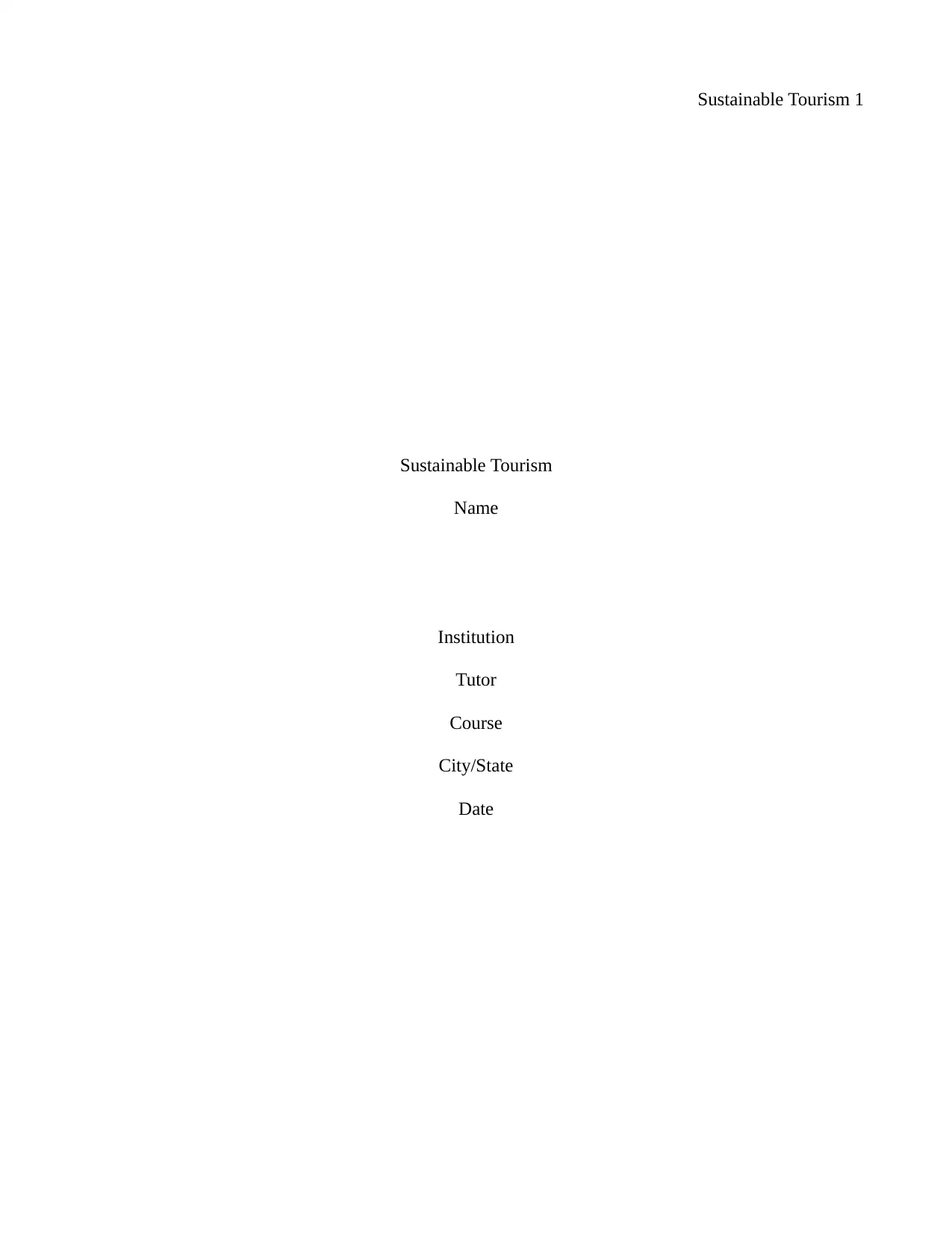
Sustainable Tourism 1
Sustainable Tourism
Name
Institution
Tutor
Course
City/State
Date
Sustainable Tourism
Name
Institution
Tutor
Course
City/State
Date
Paraphrase This Document
Need a fresh take? Get an instant paraphrase of this document with our AI Paraphraser
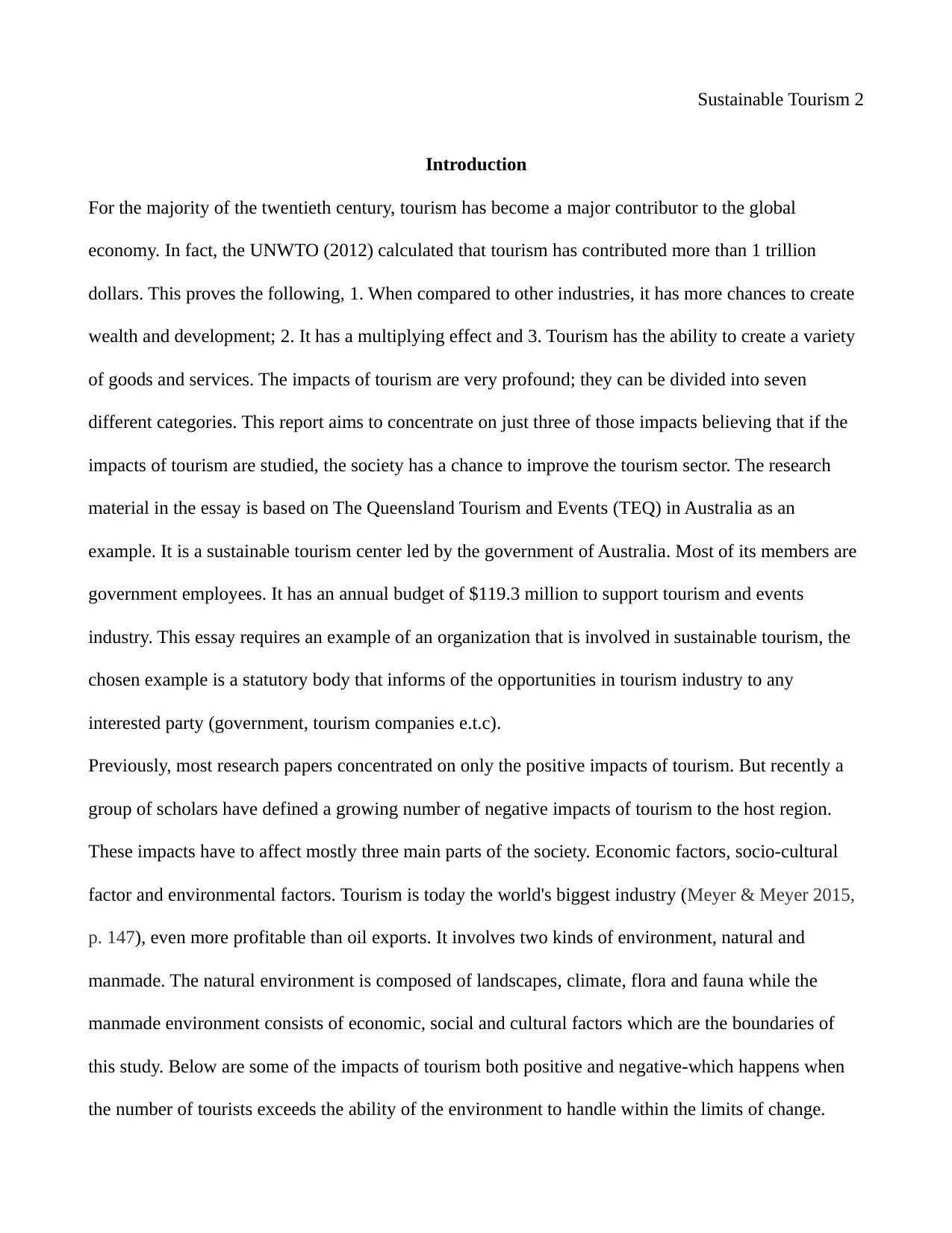
Sustainable Tourism 2
Introduction
For the majority of the twentieth century, tourism has become a major contributor to the global
economy. In fact, the UNWTO (2012) calculated that tourism has contributed more than 1 trillion
dollars. This proves the following, 1. When compared to other industries, it has more chances to create
wealth and development; 2. It has a multiplying effect and 3. Tourism has the ability to create a variety
of goods and services. The impacts of tourism are very profound; they can be divided into seven
different categories. This report aims to concentrate on just three of those impacts believing that if the
impacts of tourism are studied, the society has a chance to improve the tourism sector. The research
material in the essay is based on The Queensland Tourism and Events (TEQ) in Australia as an
example. It is a sustainable tourism center led by the government of Australia. Most of its members are
government employees. It has an annual budget of $119.3 million to support tourism and events
industry. This essay requires an example of an organization that is involved in sustainable tourism, the
chosen example is a statutory body that informs of the opportunities in tourism industry to any
interested party (government, tourism companies e.t.c).
Previously, most research papers concentrated on only the positive impacts of tourism. But recently a
group of scholars have defined a growing number of negative impacts of tourism to the host region.
These impacts have to affect mostly three main parts of the society. Economic factors, socio-cultural
factor and environmental factors. Tourism is today the world's biggest industry (Meyer & Meyer 2015,
p. 147), even more profitable than oil exports. It involves two kinds of environment, natural and
manmade. The natural environment is composed of landscapes, climate, flora and fauna while the
manmade environment consists of economic, social and cultural factors which are the boundaries of
this study. Below are some of the impacts of tourism both positive and negative-which happens when
the number of tourists exceeds the ability of the environment to handle within the limits of change.
Introduction
For the majority of the twentieth century, tourism has become a major contributor to the global
economy. In fact, the UNWTO (2012) calculated that tourism has contributed more than 1 trillion
dollars. This proves the following, 1. When compared to other industries, it has more chances to create
wealth and development; 2. It has a multiplying effect and 3. Tourism has the ability to create a variety
of goods and services. The impacts of tourism are very profound; they can be divided into seven
different categories. This report aims to concentrate on just three of those impacts believing that if the
impacts of tourism are studied, the society has a chance to improve the tourism sector. The research
material in the essay is based on The Queensland Tourism and Events (TEQ) in Australia as an
example. It is a sustainable tourism center led by the government of Australia. Most of its members are
government employees. It has an annual budget of $119.3 million to support tourism and events
industry. This essay requires an example of an organization that is involved in sustainable tourism, the
chosen example is a statutory body that informs of the opportunities in tourism industry to any
interested party (government, tourism companies e.t.c).
Previously, most research papers concentrated on only the positive impacts of tourism. But recently a
group of scholars have defined a growing number of negative impacts of tourism to the host region.
These impacts have to affect mostly three main parts of the society. Economic factors, socio-cultural
factor and environmental factors. Tourism is today the world's biggest industry (Meyer & Meyer 2015,
p. 147), even more profitable than oil exports. It involves two kinds of environment, natural and
manmade. The natural environment is composed of landscapes, climate, flora and fauna while the
manmade environment consists of economic, social and cultural factors which are the boundaries of
this study. Below are some of the impacts of tourism both positive and negative-which happens when
the number of tourists exceeds the ability of the environment to handle within the limits of change.
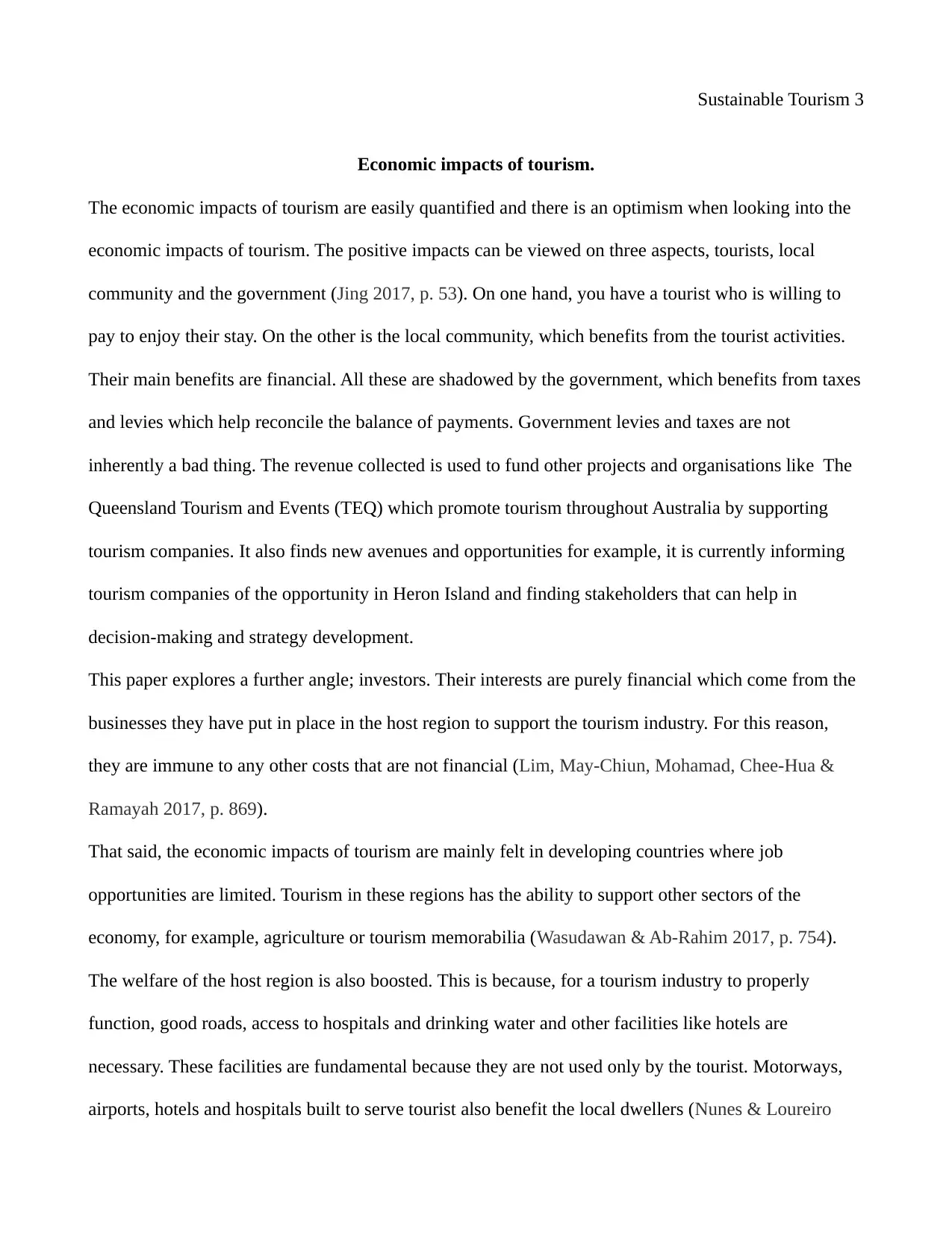
Sustainable Tourism 3
Economic impacts of tourism.
The economic impacts of tourism are easily quantified and there is an optimism when looking into the
economic impacts of tourism. The positive impacts can be viewed on three aspects, tourists, local
community and the government (Jing 2017, p. 53). On one hand, you have a tourist who is willing to
pay to enjoy their stay. On the other is the local community, which benefits from the tourist activities.
Their main benefits are financial. All these are shadowed by the government, which benefits from taxes
and levies which help reconcile the balance of payments. Government levies and taxes are not
inherently a bad thing. The revenue collected is used to fund other projects and organisations like The
Queensland Tourism and Events (TEQ) which promote tourism throughout Australia by supporting
tourism companies. It also finds new avenues and opportunities for example, it is currently informing
tourism companies of the opportunity in Heron Island and finding stakeholders that can help in
decision-making and strategy development.
This paper explores a further angle; investors. Their interests are purely financial which come from the
businesses they have put in place in the host region to support the tourism industry. For this reason,
they are immune to any other costs that are not financial (Lim, May-Chiun, Mohamad, Chee-Hua &
Ramayah 2017, p. 869).
That said, the economic impacts of tourism are mainly felt in developing countries where job
opportunities are limited. Tourism in these regions has the ability to support other sectors of the
economy, for example, agriculture or tourism memorabilia (Wasudawan & Ab-Rahim 2017, p. 754).
The welfare of the host region is also boosted. This is because, for a tourism industry to properly
function, good roads, access to hospitals and drinking water and other facilities like hotels are
necessary. These facilities are fundamental because they are not used only by the tourist. Motorways,
airports, hotels and hospitals built to serve tourist also benefit the local dwellers (Nunes & Loureiro
Economic impacts of tourism.
The economic impacts of tourism are easily quantified and there is an optimism when looking into the
economic impacts of tourism. The positive impacts can be viewed on three aspects, tourists, local
community and the government (Jing 2017, p. 53). On one hand, you have a tourist who is willing to
pay to enjoy their stay. On the other is the local community, which benefits from the tourist activities.
Their main benefits are financial. All these are shadowed by the government, which benefits from taxes
and levies which help reconcile the balance of payments. Government levies and taxes are not
inherently a bad thing. The revenue collected is used to fund other projects and organisations like The
Queensland Tourism and Events (TEQ) which promote tourism throughout Australia by supporting
tourism companies. It also finds new avenues and opportunities for example, it is currently informing
tourism companies of the opportunity in Heron Island and finding stakeholders that can help in
decision-making and strategy development.
This paper explores a further angle; investors. Their interests are purely financial which come from the
businesses they have put in place in the host region to support the tourism industry. For this reason,
they are immune to any other costs that are not financial (Lim, May-Chiun, Mohamad, Chee-Hua &
Ramayah 2017, p. 869).
That said, the economic impacts of tourism are mainly felt in developing countries where job
opportunities are limited. Tourism in these regions has the ability to support other sectors of the
economy, for example, agriculture or tourism memorabilia (Wasudawan & Ab-Rahim 2017, p. 754).
The welfare of the host region is also boosted. This is because, for a tourism industry to properly
function, good roads, access to hospitals and drinking water and other facilities like hotels are
necessary. These facilities are fundamental because they are not used only by the tourist. Motorways,
airports, hotels and hospitals built to serve tourist also benefit the local dwellers (Nunes & Loureiro
⊘ This is a preview!⊘
Do you want full access?
Subscribe today to unlock all pages.

Trusted by 1+ million students worldwide

Sustainable Tourism 4
2016, p. 365).
On the negative side, the jobs created by tourism industries are low wages and mostly seasonal. Plus,
tourism industry requires a specific set of skills that are of low specialization and therefore low salary.
It was also discovered that although the economic benefits of tourism are obvious, it also created a rift
between social classes and the regions. It was also witnessed that the allocation of resources by the
government are discriminatory in that, the government favours those areas with tourism opportunities
at the expense of the local occupants (Linderová 2017, p. 210).
To conclude this sector, the main agenda of the local host community should be to benefit from tourism
and not have to bear costs from the tourism industry (Linderová 2017, p. 210).
Socio-cultural impacts of tourism.
Tourism is the platform for different cultures to interact directly thereby revitalising the culture of the
host region. In addition, the tourism industry is much more responsive to educated and informed area
that can provide the best services for the tourists; this means that socially, tourism promotes education
(Kiper, Uzun & Topal 2016, p. 6139). These improved interactions assist generate new ideas, morals
and inspiration for social and economic development, for example, The Queensland Tourism and
Events (TEQ) is planning to open up the forefront to of Australian tourism industry by exploring the
Asian strategy, a strategy that aims at learning how to better satisfying the needs of an Asian traveler to
expand the industry further by welcoming more tourists from Asia.
The interaction between locals and tourist occur in four stages: euphoria- where the locals welcome the
visitors wholesomely. Apathy-improved community-tourists relationship. Discomfort- the saturation of
this previously euphoric relationship and finally antagonism- the irritation of locals by the tourists
(Medina-Muñoz, Medina-Muñoz & Gutiérrez-Pérez 2016, p. 270). One of the social impacts of tourism
is globalisation which results in consumerisation (the increased consumption of a variety of goods or
2016, p. 365).
On the negative side, the jobs created by tourism industries are low wages and mostly seasonal. Plus,
tourism industry requires a specific set of skills that are of low specialization and therefore low salary.
It was also discovered that although the economic benefits of tourism are obvious, it also created a rift
between social classes and the regions. It was also witnessed that the allocation of resources by the
government are discriminatory in that, the government favours those areas with tourism opportunities
at the expense of the local occupants (Linderová 2017, p. 210).
To conclude this sector, the main agenda of the local host community should be to benefit from tourism
and not have to bear costs from the tourism industry (Linderová 2017, p. 210).
Socio-cultural impacts of tourism.
Tourism is the platform for different cultures to interact directly thereby revitalising the culture of the
host region. In addition, the tourism industry is much more responsive to educated and informed area
that can provide the best services for the tourists; this means that socially, tourism promotes education
(Kiper, Uzun & Topal 2016, p. 6139). These improved interactions assist generate new ideas, morals
and inspiration for social and economic development, for example, The Queensland Tourism and
Events (TEQ) is planning to open up the forefront to of Australian tourism industry by exploring the
Asian strategy, a strategy that aims at learning how to better satisfying the needs of an Asian traveler to
expand the industry further by welcoming more tourists from Asia.
The interaction between locals and tourist occur in four stages: euphoria- where the locals welcome the
visitors wholesomely. Apathy-improved community-tourists relationship. Discomfort- the saturation of
this previously euphoric relationship and finally antagonism- the irritation of locals by the tourists
(Medina-Muñoz, Medina-Muñoz & Gutiérrez-Pérez 2016, p. 270). One of the social impacts of tourism
is globalisation which results in consumerisation (the increased consumption of a variety of goods or
Paraphrase This Document
Need a fresh take? Get an instant paraphrase of this document with our AI Paraphraser
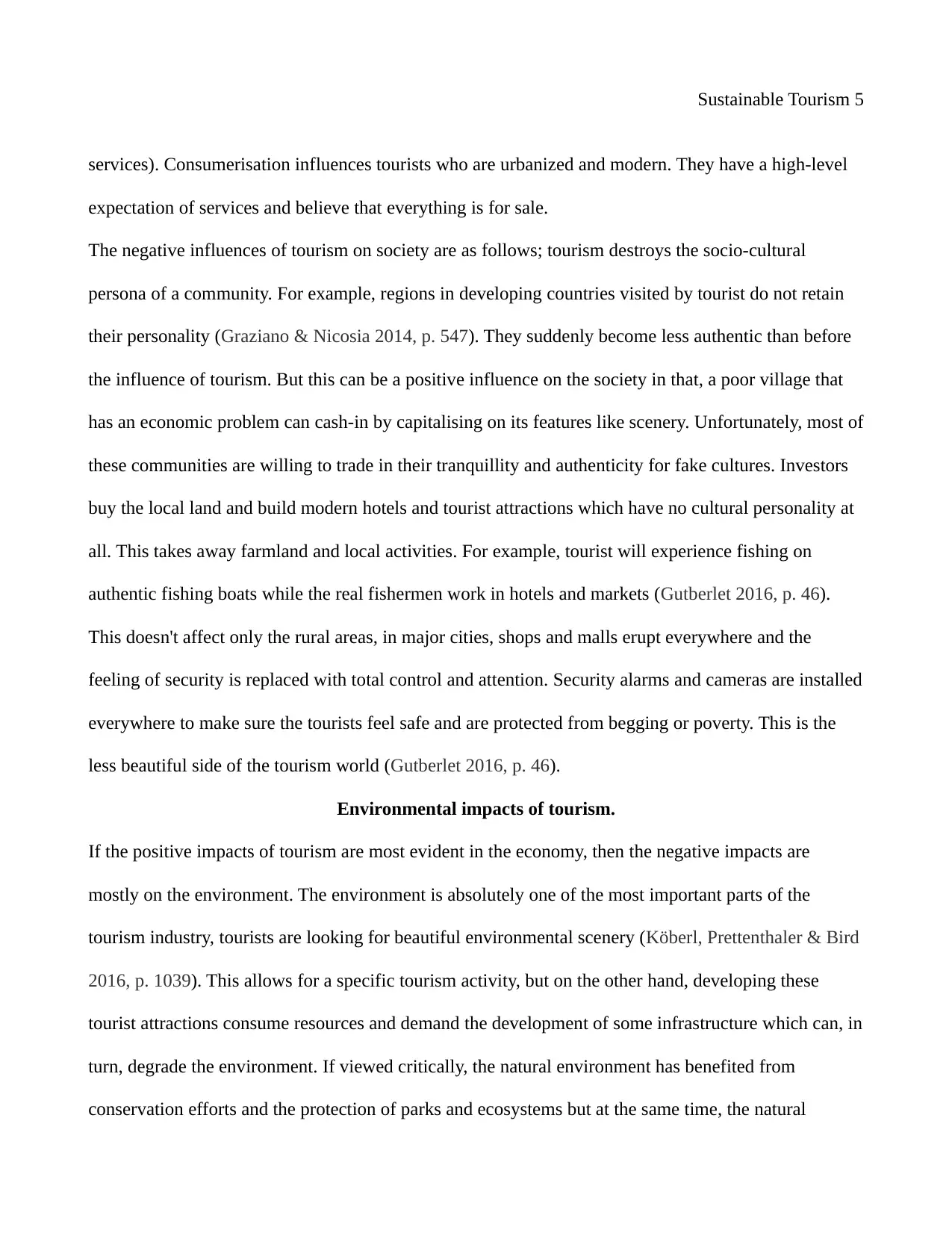
Sustainable Tourism 5
services). Consumerisation influences tourists who are urbanized and modern. They have a high-level
expectation of services and believe that everything is for sale.
The negative influences of tourism on society are as follows; tourism destroys the socio-cultural
persona of a community. For example, regions in developing countries visited by tourist do not retain
their personality (Graziano & Nicosia 2014, p. 547). They suddenly become less authentic than before
the influence of tourism. But this can be a positive influence on the society in that, a poor village that
has an economic problem can cash-in by capitalising on its features like scenery. Unfortunately, most of
these communities are willing to trade in their tranquillity and authenticity for fake cultures. Investors
buy the local land and build modern hotels and tourist attractions which have no cultural personality at
all. This takes away farmland and local activities. For example, tourist will experience fishing on
authentic fishing boats while the real fishermen work in hotels and markets (Gutberlet 2016, p. 46).
This doesn't affect only the rural areas, in major cities, shops and malls erupt everywhere and the
feeling of security is replaced with total control and attention. Security alarms and cameras are installed
everywhere to make sure the tourists feel safe and are protected from begging or poverty. This is the
less beautiful side of the tourism world (Gutberlet 2016, p. 46).
Environmental impacts of tourism.
If the positive impacts of tourism are most evident in the economy, then the negative impacts are
mostly on the environment. The environment is absolutely one of the most important parts of the
tourism industry, tourists are looking for beautiful environmental scenery (Köberl, Prettenthaler & Bird
2016, p. 1039). This allows for a specific tourism activity, but on the other hand, developing these
tourist attractions consume resources and demand the development of some infrastructure which can, in
turn, degrade the environment. If viewed critically, the natural environment has benefited from
conservation efforts and the protection of parks and ecosystems but at the same time, the natural
services). Consumerisation influences tourists who are urbanized and modern. They have a high-level
expectation of services and believe that everything is for sale.
The negative influences of tourism on society are as follows; tourism destroys the socio-cultural
persona of a community. For example, regions in developing countries visited by tourist do not retain
their personality (Graziano & Nicosia 2014, p. 547). They suddenly become less authentic than before
the influence of tourism. But this can be a positive influence on the society in that, a poor village that
has an economic problem can cash-in by capitalising on its features like scenery. Unfortunately, most of
these communities are willing to trade in their tranquillity and authenticity for fake cultures. Investors
buy the local land and build modern hotels and tourist attractions which have no cultural personality at
all. This takes away farmland and local activities. For example, tourist will experience fishing on
authentic fishing boats while the real fishermen work in hotels and markets (Gutberlet 2016, p. 46).
This doesn't affect only the rural areas, in major cities, shops and malls erupt everywhere and the
feeling of security is replaced with total control and attention. Security alarms and cameras are installed
everywhere to make sure the tourists feel safe and are protected from begging or poverty. This is the
less beautiful side of the tourism world (Gutberlet 2016, p. 46).
Environmental impacts of tourism.
If the positive impacts of tourism are most evident in the economy, then the negative impacts are
mostly on the environment. The environment is absolutely one of the most important parts of the
tourism industry, tourists are looking for beautiful environmental scenery (Köberl, Prettenthaler & Bird
2016, p. 1039). This allows for a specific tourism activity, but on the other hand, developing these
tourist attractions consume resources and demand the development of some infrastructure which can, in
turn, degrade the environment. If viewed critically, the natural environment has benefited from
conservation efforts and the protection of parks and ecosystems but at the same time, the natural
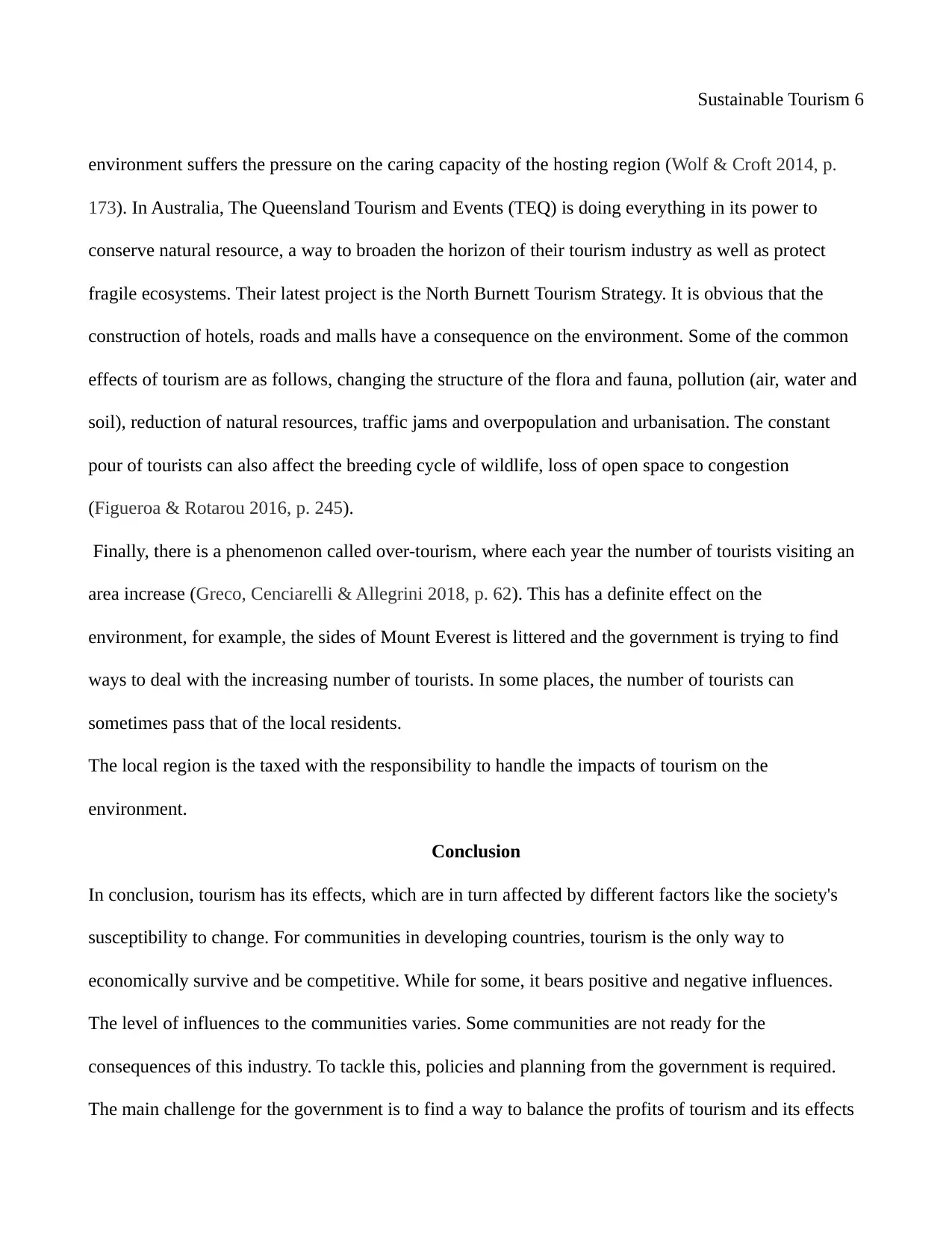
Sustainable Tourism 6
environment suffers the pressure on the caring capacity of the hosting region (Wolf & Croft 2014, p.
173). In Australia, The Queensland Tourism and Events (TEQ) is doing everything in its power to
conserve natural resource, a way to broaden the horizon of their tourism industry as well as protect
fragile ecosystems. Their latest project is the North Burnett Tourism Strategy. It is obvious that the
construction of hotels, roads and malls have a consequence on the environment. Some of the common
effects of tourism are as follows, changing the structure of the flora and fauna, pollution (air, water and
soil), reduction of natural resources, traffic jams and overpopulation and urbanisation. The constant
pour of tourists can also affect the breeding cycle of wildlife, loss of open space to congestion
(Figueroa & Rotarou 2016, p. 245).
Finally, there is a phenomenon called over-tourism, where each year the number of tourists visiting an
area increase (Greco, Cenciarelli & Allegrini 2018, p. 62). This has a definite effect on the
environment, for example, the sides of Mount Everest is littered and the government is trying to find
ways to deal with the increasing number of tourists. In some places, the number of tourists can
sometimes pass that of the local residents.
The local region is the taxed with the responsibility to handle the impacts of tourism on the
environment.
Conclusion
In conclusion, tourism has its effects, which are in turn affected by different factors like the society's
susceptibility to change. For communities in developing countries, tourism is the only way to
economically survive and be competitive. While for some, it bears positive and negative influences.
The level of influences to the communities varies. Some communities are not ready for the
consequences of this industry. To tackle this, policies and planning from the government is required.
The main challenge for the government is to find a way to balance the profits of tourism and its effects
environment suffers the pressure on the caring capacity of the hosting region (Wolf & Croft 2014, p.
173). In Australia, The Queensland Tourism and Events (TEQ) is doing everything in its power to
conserve natural resource, a way to broaden the horizon of their tourism industry as well as protect
fragile ecosystems. Their latest project is the North Burnett Tourism Strategy. It is obvious that the
construction of hotels, roads and malls have a consequence on the environment. Some of the common
effects of tourism are as follows, changing the structure of the flora and fauna, pollution (air, water and
soil), reduction of natural resources, traffic jams and overpopulation and urbanisation. The constant
pour of tourists can also affect the breeding cycle of wildlife, loss of open space to congestion
(Figueroa & Rotarou 2016, p. 245).
Finally, there is a phenomenon called over-tourism, where each year the number of tourists visiting an
area increase (Greco, Cenciarelli & Allegrini 2018, p. 62). This has a definite effect on the
environment, for example, the sides of Mount Everest is littered and the government is trying to find
ways to deal with the increasing number of tourists. In some places, the number of tourists can
sometimes pass that of the local residents.
The local region is the taxed with the responsibility to handle the impacts of tourism on the
environment.
Conclusion
In conclusion, tourism has its effects, which are in turn affected by different factors like the society's
susceptibility to change. For communities in developing countries, tourism is the only way to
economically survive and be competitive. While for some, it bears positive and negative influences.
The level of influences to the communities varies. Some communities are not ready for the
consequences of this industry. To tackle this, policies and planning from the government is required.
The main challenge for the government is to find a way to balance the profits of tourism and its effects
⊘ This is a preview!⊘
Do you want full access?
Subscribe today to unlock all pages.

Trusted by 1+ million students worldwide
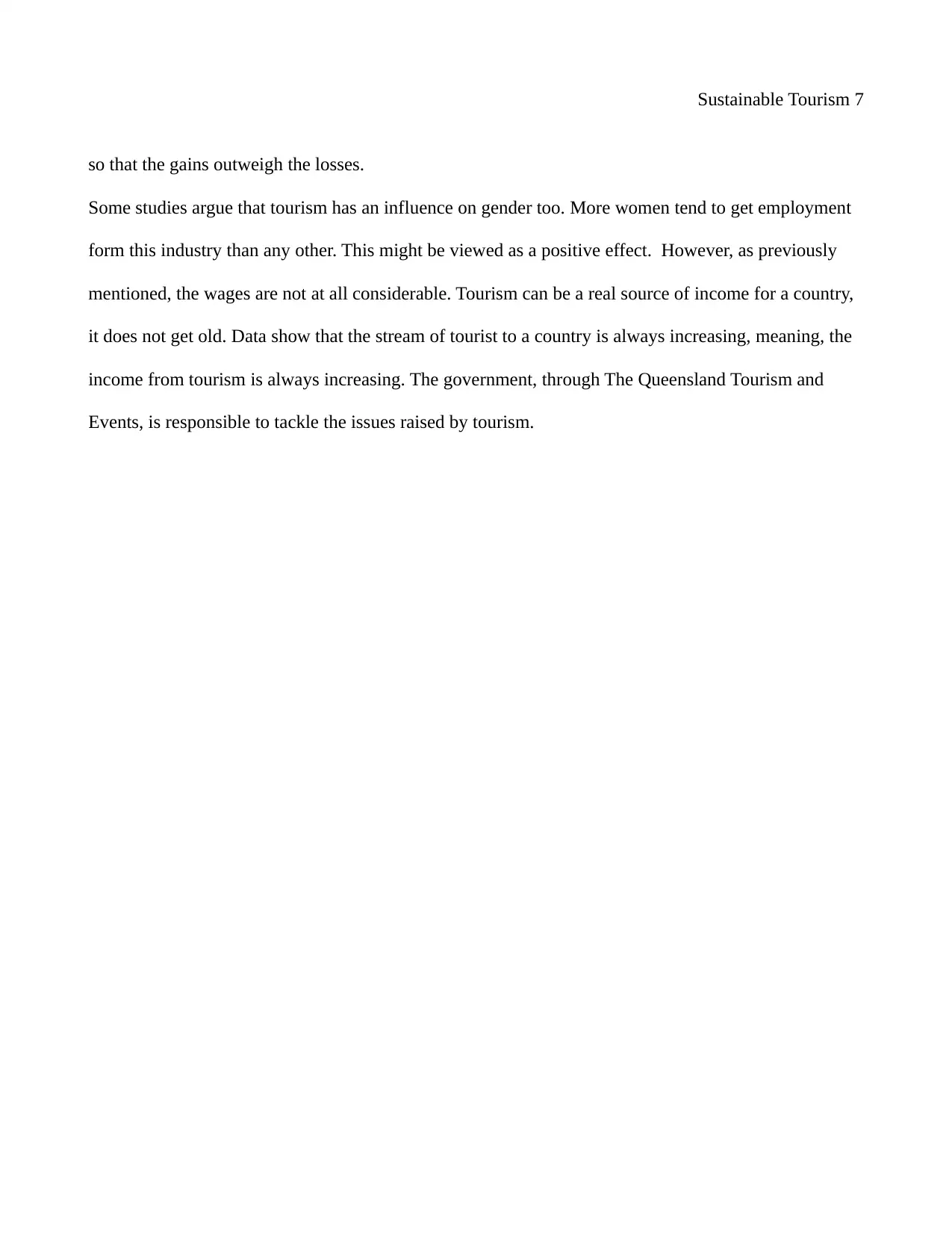
Sustainable Tourism 7
so that the gains outweigh the losses.
Some studies argue that tourism has an influence on gender too. More women tend to get employment
form this industry than any other. This might be viewed as a positive effect. However, as previously
mentioned, the wages are not at all considerable. Tourism can be a real source of income for a country,
it does not get old. Data show that the stream of tourist to a country is always increasing, meaning, the
income from tourism is always increasing. The government, through The Queensland Tourism and
Events, is responsible to tackle the issues raised by tourism.
so that the gains outweigh the losses.
Some studies argue that tourism has an influence on gender too. More women tend to get employment
form this industry than any other. This might be viewed as a positive effect. However, as previously
mentioned, the wages are not at all considerable. Tourism can be a real source of income for a country,
it does not get old. Data show that the stream of tourist to a country is always increasing, meaning, the
income from tourism is always increasing. The government, through The Queensland Tourism and
Events, is responsible to tackle the issues raised by tourism.
Paraphrase This Document
Need a fresh take? Get an instant paraphrase of this document with our AI Paraphraser
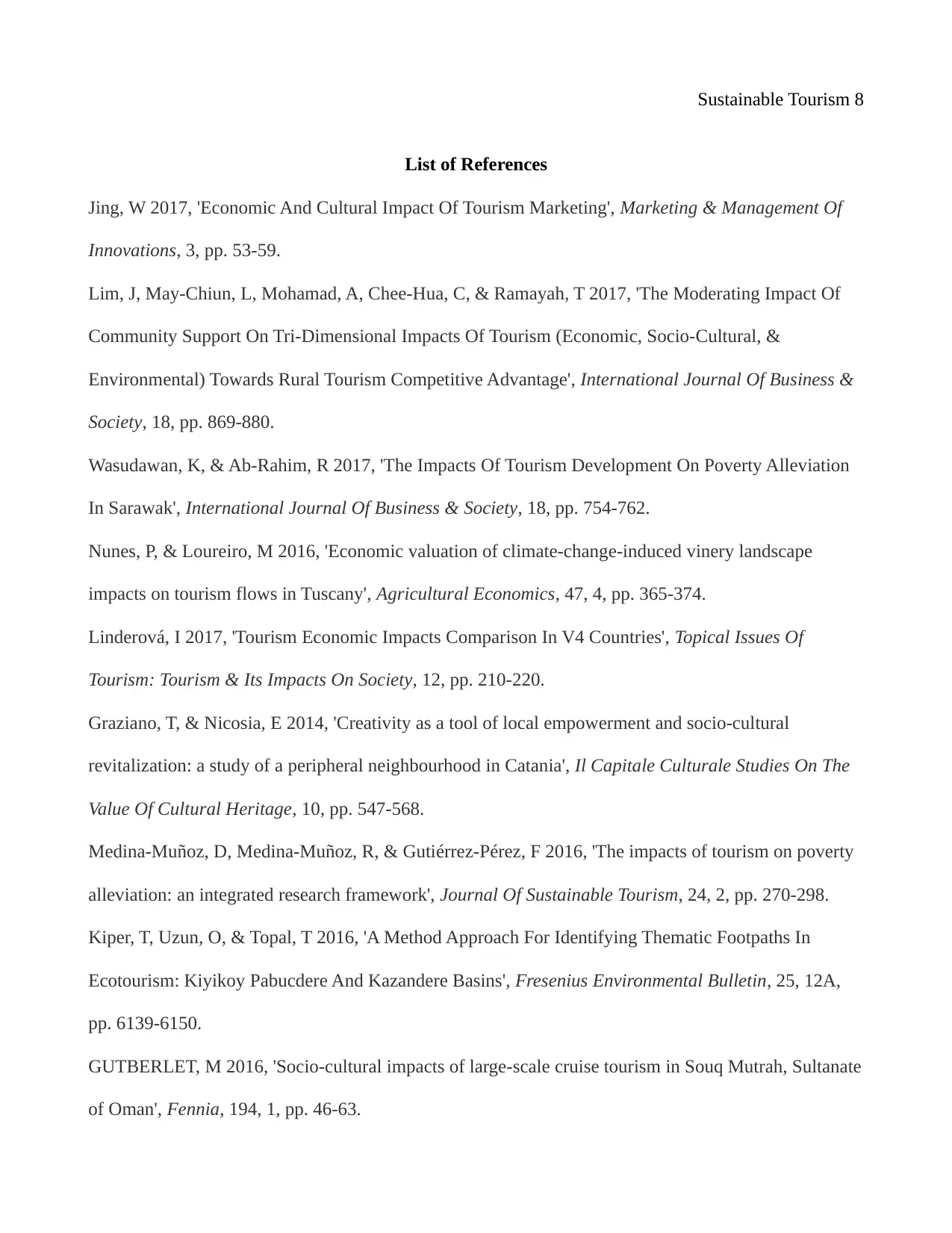
Sustainable Tourism 8
List of References
Jing, W 2017, 'Economic And Cultural Impact Of Tourism Marketing', Marketing & Management Of
Innovations, 3, pp. 53-59.
Lim, J, May-Chiun, L, Mohamad, A, Chee-Hua, C, & Ramayah, T 2017, 'The Moderating Impact Of
Community Support On Tri-Dimensional Impacts Of Tourism (Economic, Socio-Cultural, &
Environmental) Towards Rural Tourism Competitive Advantage', International Journal Of Business &
Society, 18, pp. 869-880.
Wasudawan, K, & Ab-Rahim, R 2017, 'The Impacts Of Tourism Development On Poverty Alleviation
In Sarawak', International Journal Of Business & Society, 18, pp. 754-762.
Nunes, P, & Loureiro, M 2016, 'Economic valuation of climate-change-induced vinery landscape
impacts on tourism flows in Tuscany', Agricultural Economics, 47, 4, pp. 365-374.
Linderová, I 2017, 'Tourism Economic Impacts Comparison In V4 Countries', Topical Issues Of
Tourism: Tourism & Its Impacts On Society, 12, pp. 210-220.
Graziano, T, & Nicosia, E 2014, 'Creativity as a tool of local empowerment and socio-cultural
revitalization: a study of a peripheral neighbourhood in Catania', Il Capitale Culturale Studies On The
Value Of Cultural Heritage, 10, pp. 547-568.
Medina-Muñoz, D, Medina-Muñoz, R, & Gutiérrez-Pérez, F 2016, 'The impacts of tourism on poverty
alleviation: an integrated research framework', Journal Of Sustainable Tourism, 24, 2, pp. 270-298.
Kiper, T, Uzun, O, & Topal, T 2016, 'A Method Approach For Identifying Thematic Footpaths In
Ecotourism: Kiyikoy Pabucdere And Kazandere Basins', Fresenius Environmental Bulletin, 25, 12A,
pp. 6139-6150.
GUTBERLET, M 2016, 'Socio-cultural impacts of large-scale cruise tourism in Souq Mutrah, Sultanate
of Oman', Fennia, 194, 1, pp. 46-63.
List of References
Jing, W 2017, 'Economic And Cultural Impact Of Tourism Marketing', Marketing & Management Of
Innovations, 3, pp. 53-59.
Lim, J, May-Chiun, L, Mohamad, A, Chee-Hua, C, & Ramayah, T 2017, 'The Moderating Impact Of
Community Support On Tri-Dimensional Impacts Of Tourism (Economic, Socio-Cultural, &
Environmental) Towards Rural Tourism Competitive Advantage', International Journal Of Business &
Society, 18, pp. 869-880.
Wasudawan, K, & Ab-Rahim, R 2017, 'The Impacts Of Tourism Development On Poverty Alleviation
In Sarawak', International Journal Of Business & Society, 18, pp. 754-762.
Nunes, P, & Loureiro, M 2016, 'Economic valuation of climate-change-induced vinery landscape
impacts on tourism flows in Tuscany', Agricultural Economics, 47, 4, pp. 365-374.
Linderová, I 2017, 'Tourism Economic Impacts Comparison In V4 Countries', Topical Issues Of
Tourism: Tourism & Its Impacts On Society, 12, pp. 210-220.
Graziano, T, & Nicosia, E 2014, 'Creativity as a tool of local empowerment and socio-cultural
revitalization: a study of a peripheral neighbourhood in Catania', Il Capitale Culturale Studies On The
Value Of Cultural Heritage, 10, pp. 547-568.
Medina-Muñoz, D, Medina-Muñoz, R, & Gutiérrez-Pérez, F 2016, 'The impacts of tourism on poverty
alleviation: an integrated research framework', Journal Of Sustainable Tourism, 24, 2, pp. 270-298.
Kiper, T, Uzun, O, & Topal, T 2016, 'A Method Approach For Identifying Thematic Footpaths In
Ecotourism: Kiyikoy Pabucdere And Kazandere Basins', Fresenius Environmental Bulletin, 25, 12A,
pp. 6139-6150.
GUTBERLET, M 2016, 'Socio-cultural impacts of large-scale cruise tourism in Souq Mutrah, Sultanate
of Oman', Fennia, 194, 1, pp. 46-63.
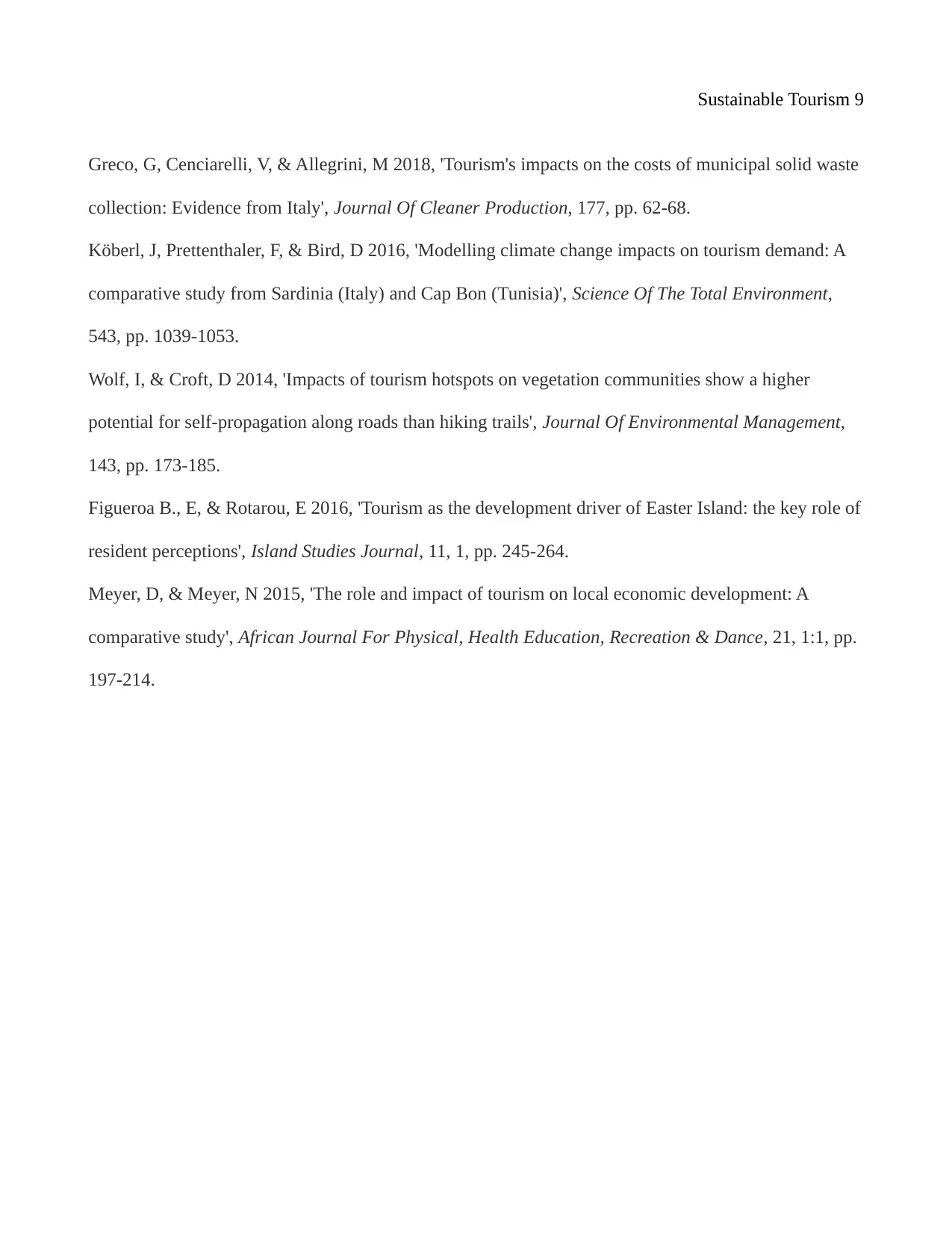
Sustainable Tourism 9
Greco, G, Cenciarelli, V, & Allegrini, M 2018, 'Tourism's impacts on the costs of municipal solid waste
collection: Evidence from Italy', Journal Of Cleaner Production, 177, pp. 62-68.
Köberl, J, Prettenthaler, F, & Bird, D 2016, 'Modelling climate change impacts on tourism demand: A
comparative study from Sardinia (Italy) and Cap Bon (Tunisia)', Science Of The Total Environment,
543, pp. 1039-1053.
Wolf, I, & Croft, D 2014, 'Impacts of tourism hotspots on vegetation communities show a higher
potential for self-propagation along roads than hiking trails', Journal Of Environmental Management,
143, pp. 173-185.
Figueroa B., E, & Rotarou, E 2016, 'Tourism as the development driver of Easter Island: the key role of
resident perceptions', Island Studies Journal, 11, 1, pp. 245-264.
Meyer, D, & Meyer, N 2015, 'The role and impact of tourism on local economic development: A
comparative study', African Journal For Physical, Health Education, Recreation & Dance, 21, 1:1, pp.
197-214.
Greco, G, Cenciarelli, V, & Allegrini, M 2018, 'Tourism's impacts on the costs of municipal solid waste
collection: Evidence from Italy', Journal Of Cleaner Production, 177, pp. 62-68.
Köberl, J, Prettenthaler, F, & Bird, D 2016, 'Modelling climate change impacts on tourism demand: A
comparative study from Sardinia (Italy) and Cap Bon (Tunisia)', Science Of The Total Environment,
543, pp. 1039-1053.
Wolf, I, & Croft, D 2014, 'Impacts of tourism hotspots on vegetation communities show a higher
potential for self-propagation along roads than hiking trails', Journal Of Environmental Management,
143, pp. 173-185.
Figueroa B., E, & Rotarou, E 2016, 'Tourism as the development driver of Easter Island: the key role of
resident perceptions', Island Studies Journal, 11, 1, pp. 245-264.
Meyer, D, & Meyer, N 2015, 'The role and impact of tourism on local economic development: A
comparative study', African Journal For Physical, Health Education, Recreation & Dance, 21, 1:1, pp.
197-214.
⊘ This is a preview!⊘
Do you want full access?
Subscribe today to unlock all pages.

Trusted by 1+ million students worldwide
1 out of 9
Related Documents
Your All-in-One AI-Powered Toolkit for Academic Success.
+13062052269
info@desklib.com
Available 24*7 on WhatsApp / Email
![[object Object]](/_next/static/media/star-bottom.7253800d.svg)
Unlock your academic potential
Copyright © 2020–2025 A2Z Services. All Rights Reserved. Developed and managed by ZUCOL.





